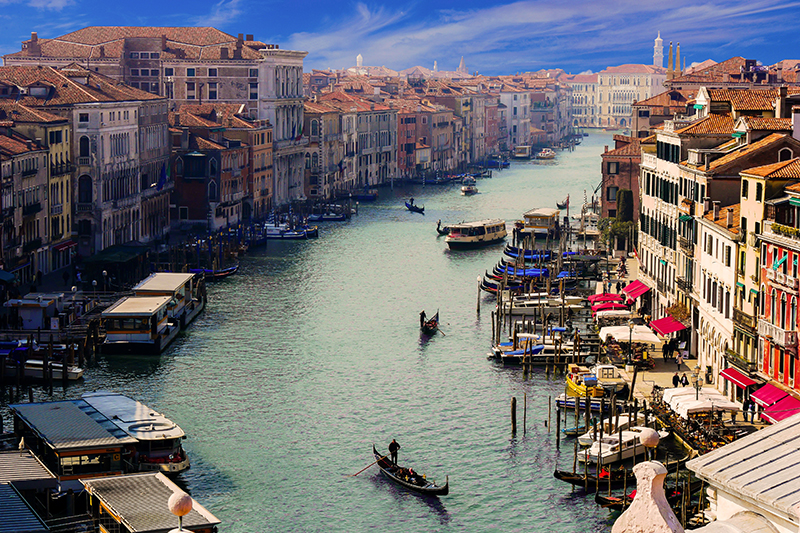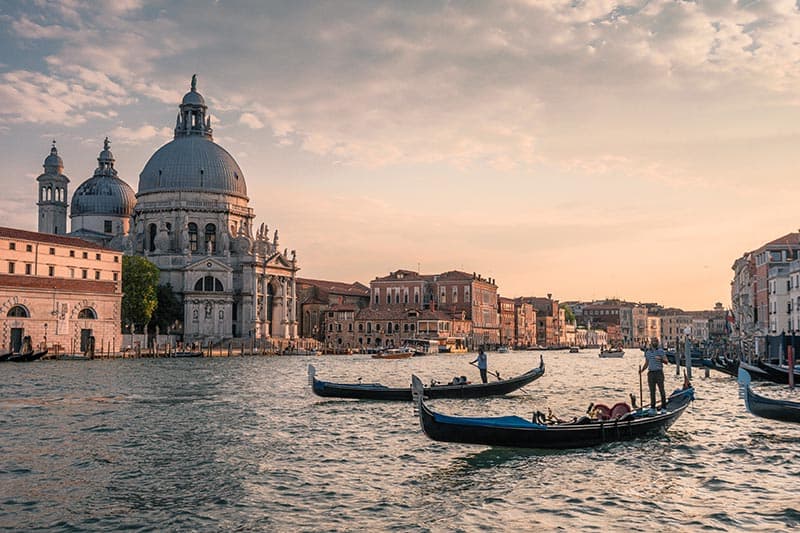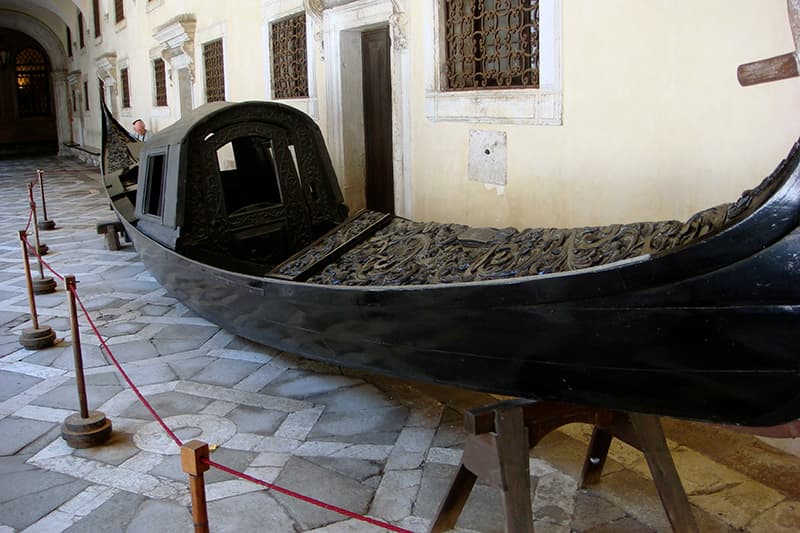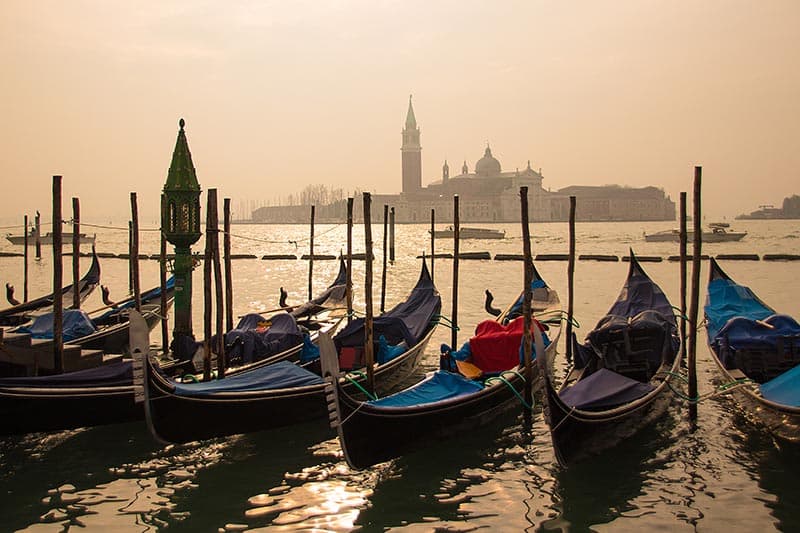As well as a peppering of intricately carved Venetian gondolas, Venice’s canals are filled with a variety of motorboats, ranging from the “vaporetti”, public water buses run by the municipal transport system, to private motor-launch taxis. Other specialized craft, such as barges carrying fruit and vegetables, waste barges, ambulance and police launches, and boats filled with tourists’ luggage, make up a water-scene of endless colour and variety.
Venice’s landscape is as much a product of its economic activities, past and present, as of its physical environment. The enduring foundation of Venetian wealth was its maritime commerce, initially in local products such as fish and salt from the lagoon, but rapidly expanded to include rich stores of merchandise as Venice became the midpoint between Europe, the Middle East and Asia.
Venetian trade required well-constructed vessels both for transport and for protection from pirates, rivals and Turkish military forces. Shipbuilding inevitably became a major industry and occupied a whole sector in the northeast of the city known as the Arsenal – a vast assemblage of basins, yards and workshops for making sails, ropes and ordnance.
A Symbol of Venice
However, perhaps the best-known form of transport is the Venetian gondola. While today there are only several hundred of these unique, keel-less boats left, their elegant, sleek shape and gleaming black paintwork have made them a symbol of Venice. Many writers have described the romance of a gondola ride in Venice, and tourists are still willing to pay the high prices asked to be rowed at twilight through the canals to the lulling song of a gondolier.
But it has been many years since Venetian gondoliers could recite verses from such Italian poets as Arisoto or Tasso while manoeuvring their amazingly flexible craft around the sharp bends of the minor canals. Many gondolas in Italy still serve as ferries across the Grand Canal, but the great cost of maintenance makes their ultimate disappearance even more likely.
Well-suited to the conditions of the Venetian canals and lagoon, gondolas are typically propelled by a gondolier, who uses an oar. The uniqueness of the gondola includes it being asymmetrical along its length making the single-oar propulsion more efficient, and for centuries the gondola was a major means of transportation and the most common watercraft within Venice. Despite their gradual decline in numbers, Venetian gondolas still serve a role in the transportation of the city, albeit mainly by tourists, and continue to serve as a symbol of Venice.
Venetian Gongolas - The Devil is in the Detail
Every detail of the Venetian gondola has its own symbolism. The iron prow-head of the gondola, called “fero da prorà” or “dolfin”, is needed to balance the weight of the gondolier at the stern and has an inverted “S” shape symbolic of the twists in the Grand Canal. Under the main blade there is a kind of comb with six teeth or prongs (“rebbi”) pointing forward standing for the six districts or “sestieri” of Venice. A kind of tooth juts out backwards toward the centre of the gondola and symbolizes the island of Giudecca.
The curved top signifies the Doge’s cap, The semi-circular break between the curved top and the six teeth is said to represent the Rialto Bridge and sometimes three friezes can be seen in-between the six prongs, indicating the three main islands of the Venetian Lagoon: Murano, Burano and Torcello.
This symbolism is likely influenced by the need to explain the shape to tourists, rather than the shape being influenced by those symbols, as they are not mentioned in any writings about the gondola prior to the current evolution of the shape of the Fero.
How do Venetian Gondolas Work?
The gondolier stands on the stern facing the bow, and rows with a forward stroke followed by a compensating backward stroke. The oar rests in an elaborately carved wooden oarlock shaped to project from the side of the craft so as to allow even the slightest drag of each return stroke to pull the bow back to its forward course.
A Brief History of Venetian Gondolas
The Venetian gondola has existed in Venice since the 11th century, being first mentioned by name in 1094. It is estimated that there were eight to ten thousand gondolas during the 17th and 18th century, but there are only around four hundred in active service today. Those few that are in private ownership are either hired out to Venetians for weddings or used for racing.
Even though the gondola has become a widely publicized icon of Venice, in the times of the Republic of Venice it was by far not the only means of transportation; on the map of Venice created by Jacopo de’ Barbari in 1500, only a fraction of the boats are gondolas, the majority being galleys and other vessels.
The historical gondola was quite different from its modern form; the paintings of Canaletto and others show a much lower prow, a higher “fero”, and usually two rowers. The banana-shaped modern gondola was developed only in the 19th century by the boat-builder Tramontin, whose heirs still run the eponymous boatyard. The construction of the gondola continued to evolve until the mid-20th century, when the city government prohibited any further modifications.
Because of the Venetian gondolas flat-bottom it may also be “drifted” sideways when required but, contrary to popular belief, is never poled like a punt as the waters of Venice are too deep. Until the early 20th century, as many photographs attested, gondolas were often fitted with a “felze”, a small cabin to protect the passengers from the weather or from onlookers, and whose windows could be closed with louvered shutters – the original “Venetian blinds”.
After the elimination of the traditional felze – possibly in response to tourists’ complaints that it blocked the view – there survived for some decades a kind of vestigial summer awning, known as the “tendalin”. While in previous centuries gondolas could be many different colours, a sumptuary law of Venice required that Venetian gondolas should be painted black, and they are customarily so painted now.
How much does a gondola ride cost in Venice, Italy?
The cost of a Venetian gondola ride varies depending on several factors, such as location, duration, and time of day. In general, gondola rides in popular tourist destinations such as Venice, Italy, can range from 80-120 euros for a 30–40-minute ride. Prices may be higher during peak tourist season or for evening rides. It’s always recommended to check with local gondola tour operators or online booking sites for the most up-to-date pricing information.
How much does it cost to buy a new Venetian Gondola?
Today’s gondolas are up to 11 metres long and 1.6 metres wide and weigh approximately 350 kg (700lb). Made from 280 pieces of hand-made sections from eight different types of wood – including lime, oak, mahogany and walnut, a gondola can take up two months to construct and today the price of a new gondola is somewhere in the vicinity of €40,000.
Discover Venice aboard La Bella Vita
European Waterways guests joining hotel barge, La Bella Vita are met in Venice, offering the perfect opportunity to sample a Venetian gondola, before joining the week-long cruise between Venice and the Renaissance city of Mantua. La Bella Vita also offers a Venetian Lagoon Cruise, visiting the islands mentioned above plus so much more. For more information delivered to your doorstep, order a free copy of our brochure or perhaps have a no-obligation chat with a member of our team via our Contact Form.
 English
English
 Spanish
Spanish French
French German
German Norwegian
Norwegian Portuguese
Portuguese Swedish
Swedish Italian
Italian Russian
Russian Simplified Chinese
Simplified Chinese Japanese
Japanese




